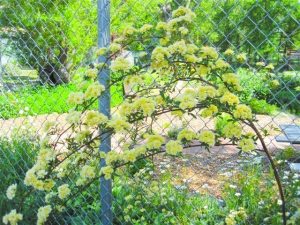For gardeners with roses, it’s almost pruning time. Pruning roses contributes to health (leaves the strongest canes on the plant), productivity (promotes flower size and quality), and longevity (stimulates new growth) of rose plants. Pruning gives the plant an attractive shape and keeps it at a desirable size.
In most of California, pruning should be done in winter before buds swell, although it may be delayed where late spring frosts are common. Anytime from now until early spring is the time to prune here in the foothills. Tools required for pruning roses consist of sharp pruning shears, long-handled loppers, a fine-toothed curved saw and a pair of rose gloves or leather
garden gloves.
Generally there are three types of pruning; severe, moderate, and light. The age, size, and growth habit of your roses determine the type you should use.
Severe or heavy pruning can be used if you want to reduce the size of the plant and promote showy, but few blooms and should be used on vigorous, well-established plants. Leave only 3-4 canes 6-10 inches long above the bud-union (where the stem joins the roots).
Moderate pruning develops a much larger bush and is the best method for most rose pruning. Leave 4-8 canes, each about 18-24 inches above the bud-union. Lastly, there is light pruning where only diseased, broken, and crossing canes are removed. Canes are cut back to 3-4 feet above the bud union.
Pruning cuts should always be made just above a strong outside bud. However, if you are removing the entire cane, cut at the bud union where the cane originated. All cuts should be made at approximately a 45 degree angle, one-fourth inch above the bud or bud union.
To begin pruning, remove all dead canes and any canes that do not show healthy growth. Next remove branches running through the middle of the bush and those rubbing on healthy branches. Always remove shoots (suckers) that may be growing below the bud-union.
Once you have accomplished those cuts, stand back and look at the plant. Are there branches that seem to make the plant lopsided? If so, cut these back or remove them completely. Thin out the remaining healthy canes to the desired height creating a bowl shape with an open center. As a general rule, between one-third and two-thirds of healthy wood may be removed. Pruning paint or other wound dressings are not necessary.
Floribundas, polyanthas, and shrub roses are grown more for the quantity of blooms than for the quality of individual blooms. Cut back previous year’s growth only by one-fourth and leave as many strong new canes and stems as the plant produced. Bush roses of the same variety can be sheared as a hedge by pruning all plants to the same height.
Climbers should not be pruned for the first two or three years. Remove only dead, weak, and twiggy wood, allowing the plants to produce long, flexible canes. Most of the blooms will come from the lateral branches that are produced on the long canes. Train the long canes along a fence or over an arbor. When pruning climbers, if the variety only blooms once a year, prune after blooming. Repeat bloomers are pruned in winter at the same time as hybrid teas and other roses. Cut back lateral canes to within two to three buds from the main canes; remove dead, weak and woody stems.
This article is adapted from a rose pruning article by former Tuolumne County Master Gardener Carolee James and information from the University of California Integrated Pest Management website, http://www.ipm.ucdavis.edu




